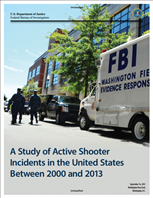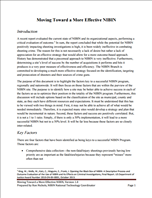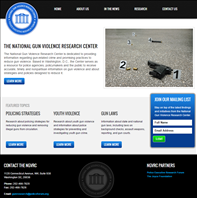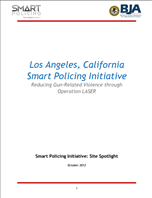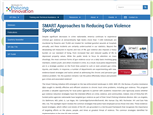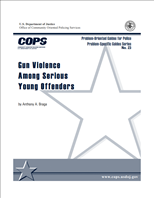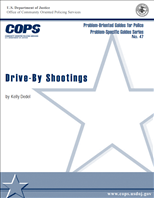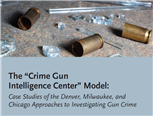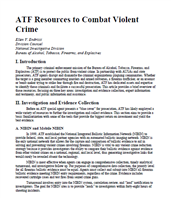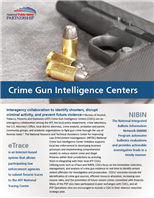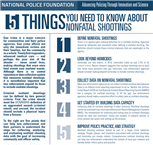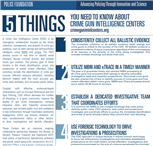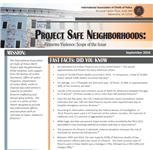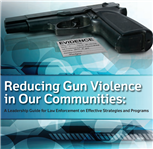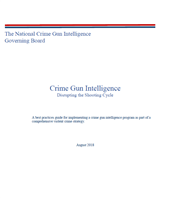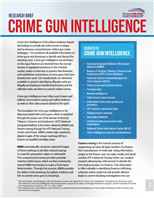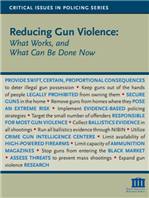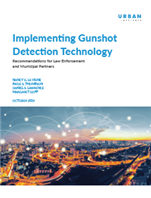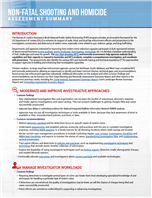A Study of Active Shooter Incidents in the United States Between 2000 and 2013
The FBI initiated this study to add to the resources available to law enforcement and others who must consider their best course of action to prepare for, respond to, and recover from active shooter incidents. Using the same criteria over a 14-year span, the FBI sought to determine whether the number of active shooter incidents had changed, concluding the trend over the study period showed a steady rise. In the first half of the years studied, the average annual number of incidents was 6.4, but that average rose in the second half of the study to 16.4, an average of more than one incident per month.
Moving Toward a More Effective NIBIN
The purpose of this document is to highlight the factors key to a successful NIBIN program, regionally and nationwide. It will then focus on those factors that are within the purview of the NIBIN site.
National Gun Violence Research Center
The National Gun Violence Research Center is dedicated to providing information regarding gun-related crime and promising practices to reduce gun violence. Based in Washington, D.C., the Center serves as a resource for police agencies, policymakers and the public to receive accurate, timely and nonpartisan information on gun violence and about strategies and policies designed to reduce it.
NIBIN Frequently Asked Questions
Frequently Asked Questions regarding ATF's National Integrated Ballistics Information Network
Reducing Gun-Related Violence through Operation LASER
The Los Angeles Smart Policing Initiative (SPI) sought to reduce gun-related violence in specific neighborhoods in the city of Los Angeles, through application of the SARA problem-solving model—Scanning, Analysis, Response, and Assessment. As part of the scanning phase, the LAPD and its research partner examined gun-related crimes by Division and by Reporting District for 2011. In 2011, the Newton Division was ranked third in gun violence among the 21 Divisions.
SMART Approaches to Reducing Gun Violence
This Spotlight report reviews the common strategies that police have employed across nine sites. These evidence-based strategies, which reflect core tenets of the Smart Policing Initiative (SPI), are grounded in a risk-focused framework that recognizes the importance of targeting efforts on the places, people, and times at greatest threat of violence.
Gun Violence Among Serious Young Offenders
This problem-specific guide addresses gun violence among serious young offenders. The guide is divided into three main areas: (1) the problem of gun violence among serious young offenders which includes related problems and factors contributing to gun violence among serious young offenders; (2) understanding the local problem by asking the right questions and measuring effectiveness; and (3) responses to the problem of gun violence among serious young offenders including offender-oriented responses, place-oriented responses, and responses with limited effectiveness. The report also presents a summary of responses to gun violence among serious young offenders, the mechanisms by which they are intended to work, the conditions under which they ought to work best, and some factors that should be considered before implementing a specific response.
Drive-By Shootings
This guide begins by describing the problem of drive-by shootings and reviewing factors that increase its risks. It then identifies a series of questions to help you analyze your local drive-by shootings problem. Finally, it reviews responses to the problem and what is known about them from evaluative research and police practice.
The National Resource Center on Domestic Violence and Firearms
Safer Families, Safer Communities, a project of the new National Domestic Violence and Firearms Resource Center, supports comprehensive implementation and enforcement of domestic violence firearm prohibitions at all levels of government. Launched in 2016, the Safer Families, Safer Communities website is the first website wholly dedicated to addressing the intersection of domestic violence and firearms. By providing information, as well as community-based strategies and examples, this project seeks to prevent domestic violence-related homicide in families and communities.
Basic Firearm Violations and Investigations
Most ATF offices can provide customized, peer-to-peer training. This training includes an overview of basic federal firearms violations, on-scene documentation of evidence in cases involving the recovery of firearms, and routine investigative follow up. This training is useful to those law enforcement officers who are likely to uncover firearm violations during the course of their primary law enforcement functions, whether patrol or investigative.
The "Crime Gun Intelligence Center" Model
Case studies of the Denver, Milwaukee, and Chicago approaches to Investigating Gun Crime
ATF Resources to Combat Violent Crime
The primary criminal enforcement mission of the Bureau of Alcohol, Tobacco, Firearms, and Explosives (ATF) is to protect the public from violent crime. In partnership with AUSAs and state prosecutors, ATF agents disrupt and dismantle the criminal organizations plaguing communities. Whether the target is a gang member committing murders and armed robberies, a firearms trafficker, or an arsonist or bomb maker trying to strike fear through fire and destruction, ATF has dedicated assets and expertise to identify those criminals and facilitate a successful prosecution. This article provides a brief overview of those resources, focusing on three key areas: investigation and evidence collection, expert information and testimony, and public information and assistance.
Crime Gun Intelligence Centers Guide
This document provides background on CGIC processes and includes a peer exchange sample guide and additional resources. Agencies interested in learning more about CGICs may find it helpful to visit an agency with an established program in a peer learning opportunity.
5 Things You Need to Know About Nonfatal Shootings
This one page fact sheet provides five key points that can help law enforcement and their partners to understand the steps for collecting, analyzing, and evaluating nonfatal shooting data with the goal of increasing community and officer safety.
5 Things You Need to Know About Crime Gun Intelligence Centers
This one page fact sheet provides five key areas that CGICs should implement to enhance effectiveness and improve outcomes.
The Value of Nonfatal Shooting Data- A Police Foundation Webinar
Most law enforcement agencies in the United States do not collect nonfatal shooting data because there is no federal crime reporting requirement. However, nonfatal shootings and homicides are closely related, and analysis of nonfatal shootings can be extremely valuable to departments. Analysis of nonfatal shootings (which occur four times as often as homicides) can serve as part of a larger crime reduction strategy and can help law enforcement better understand the context of local gun violence. This webinar will focus on defining nonfatal shootings, describing data collection methodologies, and discussing how policy and investigations can be enhanced based on nonfatal shooting data. This webinar is intended for police departments that do not collect nonfatal shooting data or those that are seeking to improve nonfatal shooting data collection and use. Police department analysts, researchers, and investigators are encouraged to attend the webinar.
Firearms Violence: Scope of the Issue
The International Association of Chiefs of Police (IACP) Project Safe Neighborhoods (PSN) Initiative, with support from the Bureau of Justice Assistance, Office of Justice Programs, Department of Justice (BJA), works to improve law enforcement’s capacity to interdict firearms trafficking and disrupt gang activity. This is one in a series of Fact Sheets designed to provide law enforcement officers and executives with an overview on topics related to firearms.
Reducing Gun Violence in Our Communities: A Leadership Guide for Law Enforcement on Effective Strategies and Programs
The overall goal of this guide is to provide information about notable programs and policing strategies that can be implemented by law enforcement agencies, regardless of size, in order to enhance the critical and life-saving mission of reducing gun violence. By highlighting innovative approaches developed by law enforcement departments and communities across the country, local leaders are encouraged to expand upon their current efforts in order to create a comprehensive program to enhance community and officer safety. The guide is structured with sections that address many existing gun violence problems including: gangs, youth violence, domestic violence, and federal firearms trafficking. If a community is experiencing a particular form of gun violence, the corresponding section of the guide offers practical information on effective countermeasures and ways to involve the community, as appropriate. Local law enforcement agencies, together with community leaders, can review this guide to learn about proactive programs and strategies that can be replicated and/or customized to fit into an individual agency’s policing model.
Oakland's Successful Gun Violence Reduction Strategy
This paper describes the Oakland Gun Violence Reduction Strategy, which has produced five consecutive years of reductions in fatal and non-fatal shootings in Oakland, reaching the second lowest level in the last 47 years in 2017. The Oakland strategy has received national attention from those concerned about gun violence both because of the continued declines in violence and also the difficult local conditions in which those reductions have been achieved. The purpose of this paper is to accurately describe the Oakland Strategy – it’s values, components and mechanics.
Crime Gun Intelligence: Disrupting the Shooting Cycle
A best practices guide for implementing a crime gun intelligence program as part of a comprehensive violent crime strategy.
PSP Research Brief: Crime Gun Intelligence
Crime Gun Intelligence (CGI) utilizes evidence-based technology to provide law enforcement a unique tool to enhance comprehensive violent gun crime strategies. CGI combines all available information on crime guns and shootings to identify and disrupt the shooting cycle. CGI reveals leads not otherwise available to assist in identifying offenders who are illegally purchasing or transferring firearms and the offenders who use them to commit violent crimes. This document reviews the past 15 years of research on these strategies from the leading experts in the field. Also included are additional sources of information and guidance on CGICs and crime gun intelligence.
Reducing Gun Violence: What Works and What Can Be Done Now
This report is the 36th publication in PERF’s Critical Issues in Policing series highlights the gun violence problem in the United States where researchers identify 4 distinct gun violence problems which make up the scope of their findings and identify nine recommendations to reduce gun violence.
Implementing Gunshot Detection Technology
The Urban Institute conducted a three-city evaluation of Gunshot Detection technology to document how agencies implement and use the technology and to assess its impacts on shooting notifications, response times, violent crime rates, and police-community relations. The cities that participated in this study are Denver, Colorado; Milwaukee, Wisconsin; and Richmond, California.
The Case for Studying Criminal Nonfatal Shootings: Evidence from Four Midwest Cities
This research paper, published in the Justice Evaluation Journal documents the similarities and differences between criminal nonfatal and fatal shooting incidents by using data from four midwest cities.
PSP Webinar: Crime Guns 101
The initial recovery and identification of a crime gun is one of the most critical steps in any investigation. This step is even more critical for agencies whose communities are experiencing high incidences of violent gun crime, are expanding their utilization of crime gun intelligence (National Integrated Ballistic Information Network [NIBIN] and the Bureau of Alcohol, Tobacco, Firearms and Explosives’ [ATF] eTrace), or are participating in a Crime Gun Intelligence Center (CGIC). These firearms provide valuable investigative leads and are subsequently scrutinized during all aspects of the investigation that follows the recovery. Despite the importance of this initial step, few officers receive training on the identification of firearms and, as a result, firearms are frequently misidentified, leading to missed opportunities for lead development, case connection, and successful prosecution. This webinar provided an overview of the NIBIN process and CGIC concept, history and relevance of ATF’s eTrace, how to properly identify and recover crime guns, and lessons learned and successes from unique cases.
PSP Nonfatal Shooting and Homicide Assessment Summary
This document intends to provide an understanding of the common themes, technical gaps, and recommendations identified among PSP sites that have received nonfatal shooting and homicide assessments.
